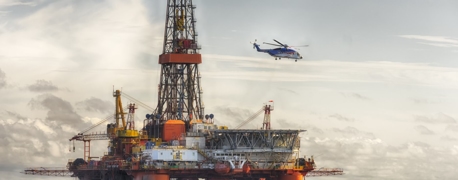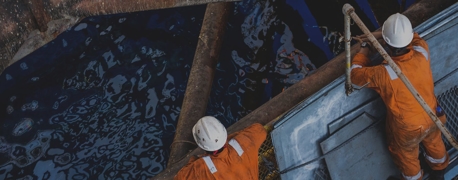How Tugboats Move Vessels 1000x Their Size & Weight

Because tugboats serve diverse functions depending on where they’re deployed, they’re defined by shared design features, including: a high power-to-weight ratio (PWR), deep and broad draft (how low the vessel sits in the water), and propellers capable of enormous thrust. Other features, including relatively new kinds of propulsion systems, are becoming the new standard for tugs.
Whatever kind of propulsion a tug crew is working with, a tugboat is mostly engine. Massive engines capable of powering three propellers on a relatively small vessel gives the typical tug a PWR of 9.5 or so—over 8 times the PWR of a container vessel. The propellers, engine, and low draft combine to create a high “bollard pull,” a measurement of thrust. Typical tugs can exert up to 110 tons of pulling and pushing force with incredible precision, especially when combined with a powerful winch.
But in today’s article, we’re diving into what specifically makes tugboats a necessary part of every port and container ship operation.
The Three Different Tugboat Types
Tugboats can be classified into three general types: conventional, tractor, and ASD.
Conventional tugboats most closely resemble older generations of tugs. These models use fixed propellers with moveable nozzles (or rudders) for maneuvering. While these models are the cheapest to produce and operate, they’re less and less suitable for the enormous “New Panamax”-sized container vessels that are growing more common in ports. However, they’re still useful for all kinds of tasks related to small or medium loads.
Tractor tugs are the updated and heavy-duty version of conventional tugs. Tractor tugs typically come with a powerful winch controlled remotely by the vessel’s pilot, allowing for fine control of the tow line and engine at the same time. Tractor tugs are designed with the engine at the bow and the towing point near the stern, which maximizes maneuverability. Their power also means they’re suitable for the largest vessels in production. However, tractor tugs are more costly to purchase and maintain than conventional tugs; they’re also unsuitable for open water due to short turning lever.
ASD tugs, which stands for Azimuthal Stern Drives, are the most advanced and most in-demand tug type at the moment. They combine features of tractor and conventional tugs, possessing an even stronger bollard pull than equivalent tractor vessels while having engines that are easier to maintain and repair. ASD tugs possess, by far, the most power and precision of any tugboat class.
Azimuth propellers rotate 360 degrees horizontally, eliminating the need for a rudder. Some azimuth propellers swing up or retract into the vessel, reducing drag at higher speeds; others have the engine attached to the propeller itself, reducing the amount of space required in the engine room and reducing vibrations and noise onboard.
Azimuth Engines Allow for Dynamic Positioning
The 360-degree propulsion system not only makes rudders redundant, but allows for a new, automated navigational tool called “dynamic positioning.” Sufficiently advanced dynamic positioning systems (which are quickly becoming standard on the most cutting-edge vessels in production) allow the propulsion system to automatically adjust to waves, wind, and other ocean forces to keep the vessel in place. Automated dynamic positioning allows the computer to make propeller adjustments faster and more often than a human operator would.
Dynamic positioning has enormous implications for tug operations involving rescue, oil-and-gas, firefighting, and docking/undocking ultra-large container vessels (ULCVs). Azimuth drives and dynamic positioning allow for extreme precision while handling large loads or navigating in rough, choppy weather. This makes them even more reliable, which in turn makes life safer for crews who rely on tugs for supply runs, emergency rescue, or other high-stakes duties.
AZ-PM Thrusters
The most cutting-edge azimuth propulsion system is an AZ-PM system, which uses magnets to spin propeller blades for thrust. These types of system reduce the space requirements of the engine room by 30%, making engines easier to repair. The use of magnets also reduces noise and vibration, which improves the efficiency of dynamic positioning systems. Magnet-powered systems raise the possibility of increasingly climate-friendly tugboat engines, which is important for reasons covered in the next section.
Tugboats & Fuel Usage
The only downside to azimuth drives is how much fuel they require. Constant adjustment and enormous power means ASD vessels use up an enormous amount of fuel over seemingly short distances. This also explains why it’s common for tug companies to charge fuel surcharges for their services. These surcharges are part of why big shipping companies minimize their use of tug services, even as container ships get bigger and come with more hazards.
Though tugboats have been around for over a century, vital uses for these small-but-mighty vessels have made them more advanced (and costly) than ever. Vessels currently in production will run on liquid natural gas and have systems in place to allow for increased automation. In time, pilots may control tugboat drones from the shore, controlling the azimuth engines remotely with precision. Companies hope to install fully automated AI systems in the future.
Whether or not that happens, it remains the responsibility of vessel owners and operators to ensure the safety of the crew on every job. When they don’t, our tugboat accident lawyers will make sure they answer for it.


